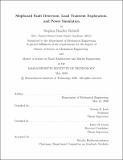| dc.contributor.advisor | Steven B. Leeb and Daisy H. Green. | en_US |
| dc.contributor.author | Kidwell, Stephen Bradley. | en_US |
| dc.contributor.other | Massachusetts Institute of Technology. Department of Mechanical Engineering. | en_US |
| dc.date.accessioned | 2020-09-03T16:48:41Z | |
| dc.date.available | 2020-09-03T16:48:41Z | |
| dc.date.copyright | 2020 | en_US |
| dc.date.issued | 2020 | en_US |
| dc.identifier.uri | https://hdl.handle.net/1721.1/126992 | |
| dc.description | Thesis: S.M., Massachusetts Institute of Technology, Department of Mechanical Engineering, May, 2020 | en_US |
| dc.description | Thesis: S.M. in Naval Architecture and Marine Engineering, Massachusetts Institute of Technology, Department of Mechanical Engineering, May, 2020 | en_US |
| dc.description | Cataloged from the official PDF of thesis. | en_US |
| dc.description | Includes bibliographical references (pages 249-251). | en_US |
| dc.description.abstract | Non-intrusive load monitoring experiments have provided useful information in practice for activity tracking, condition-based maintenance, energy scorekeeping, and fault detection through various installations over several decades. Changes in power transient behavior on electrical loads are indicative of soft faults and progressive failure. With the correct tools for laboratory and field experimentation, a library of power stream data gives researchers the signatures or observations of transient behavior required to fully identify the range of healthy and faulted behaviors that may appear, allowing for actual soft fault scenarios to be identified prior to vital equipment failure. With recent advances in power monitoring technology, lab experimentation can occur at a much greater capacity with the ability to manipulate load actuation metrics and acquire power trace data en masse. Also, reliable sensors can be installed on maritime assets in a short timeframe with extremely small footprints, allowing data collection from field studies to occur much more easily. With a vast amount of valuable data onhand, a shipboard power simulator was created to model power streams of real and theoretical shipboard power distribution systems in various operating conditions, allowing researchers access to useful data for assesment of power metrics in system design and valuation. | en_US |
| dc.description.statementofresponsibility | by Stephen Bradley Kidwell. | en_US |
| dc.format.extent | 251 pages | en_US |
| dc.language.iso | eng | en_US |
| dc.publisher | Massachusetts Institute of Technology | en_US |
| dc.rights | MIT theses may be protected by copyright. Please reuse MIT thesis content according to the MIT Libraries Permissions Policy, which is available through the URL provided. | en_US |
| dc.rights.uri | http://dspace.mit.edu/handle/1721.1/7582 | en_US |
| dc.subject | Mechanical Engineering. | en_US |
| dc.title | Shipboard fault detection, load transient exploration, and power simulation | en_US |
| dc.type | Thesis | en_US |
| dc.description.degree | S.M. | en_US |
| dc.description.degree | S.M. in Naval Architecture and Marine Engineering | en_US |
| dc.contributor.department | Massachusetts Institute of Technology. Department of Mechanical Engineering | en_US |
| dc.identifier.oclc | 1192494659 | en_US |
| dc.description.collection | S.M. Massachusetts Institute of Technology, Department of Mechanical Engineering | en_US |
| dc.description.collection | S.M.inNavalArchitectureandMarineEngineering Massachusetts Institute of Technology, Department of Mechanical Engineering | en_US |
| dspace.imported | 2020-09-03T16:48:41Z | en_US |
| mit.thesis.degree | Master | en_US |
| mit.thesis.department | MechE | en_US |
